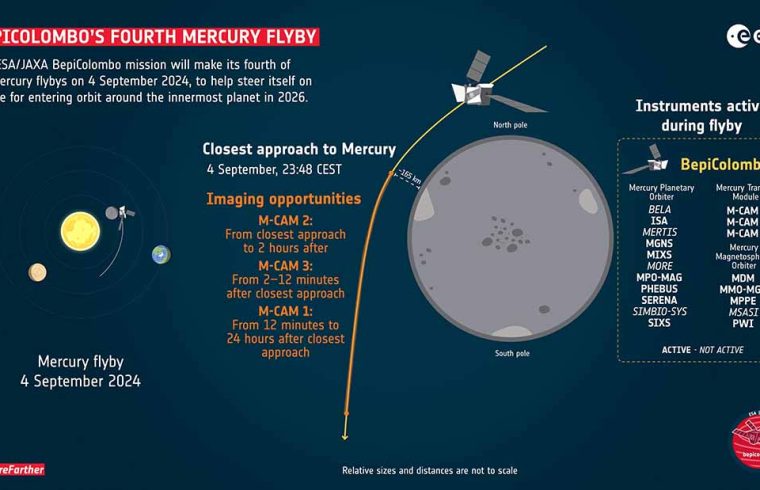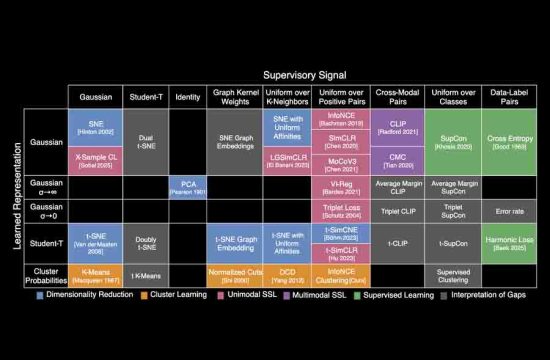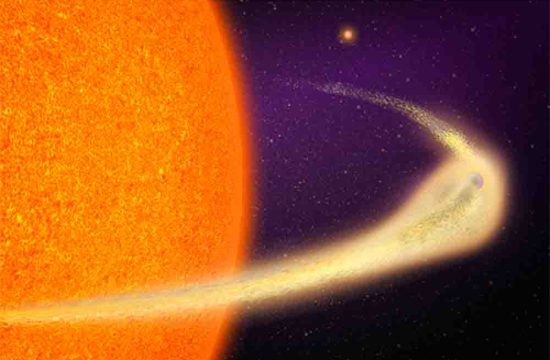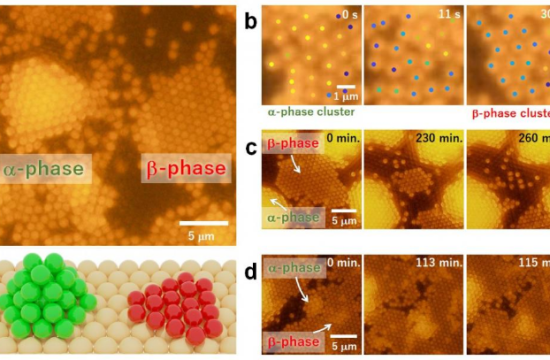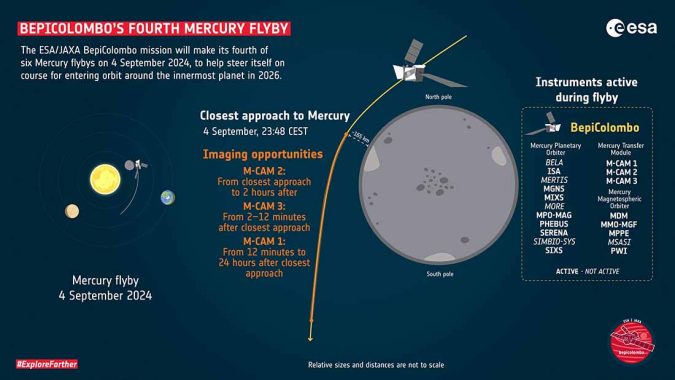
Teams from across ESA and industry have worked continuously over the past four months to overcome a glitch that prevented BepiColombo’s thrusters from operating at full power. The ESA/JAXA mission is still on track, with a new trajectory that will take it just 165 km from Mercury’s surface on Wednesday.
Taking BepiColombo closer to Mercury than it’s ever been before, this flyby will reduce the spacecraft’s speed and change its direction. It also gives us the opportunity to snap images and fine-tune science instrument operations at Mercury before the main mission begins. The closest approach is scheduled for 23:48 CEST (21:48 UTC) on 4 September.
BepiColombo launched into space in October 2018 and is making use of nine planetary flybys: one at Earth, two at Venus, and six at Mercury, to help steer itself into orbit around Mercury. Once in orbit, the main science phase of the mission can begin.
The upcoming flyby will be the fourth at Mercury. Whilst it was always in the schedule, BepiColombo will get around 35 km closer to Mercury than originally planned, due to a new route devised by ESA’s flight dynamics team.
Why is it so hard to visit Mercury?
Mercury is the least explored rocky planet in the Solar System, mainly because getting there is incredibly challenging. As BepiColombo gets closer to the Sun, the powerful gravitational pull of our star accelerates the spacecraft towards it. What’s more, the spacecraft launched from Earth with a lot of energy, travelling far too quickly to be captured into orbit around little Mercury.
Overcoming both of these hurdles would be enormously difficult using onboard thrusters alone. So BepiColombo also makes use of gravity assist flybys to help it lose energy and slow down enough to eventually be captured into orbit around Mercury.
BepiColombo’s journey to Mercury becomes even more epic
BepiColombo is unique in that it comprises two science orbiters that will circle Mercury – ESA’s Mercury Planetary Orbiter and the Japan Aerospace Exploration Agency’s (JAXA) Mercury Magnetospheric Orbiter. The two are carried together to the mysterious planet by the Mercury Transfer Module (MTM). In April 2024, BepiColombo started experiencing an issue that prevented MTM’s electric thrusters from operating at full power.
Engineers identified unexpected electric currents between MTM’s solar array and the unit responsible for extracting power and distributing it to the rest of the spacecraft. Onboard data imply that this is resulting in less power available for electric propulsion.
ESA’s BepiColombo Mission Manager, Santa Martinez explains: “Following months of investigations, we have concluded that MTM’s electric thrusters will remain operating below the minimum thrust required for an insertion into orbit around Mercury in December 2025.”
A workaround to MTM’s reduced thrust has been cleverly devised by ESA’s Flight Dynamics team. They conceived a new trajectory that maintains the baseline scientific mission at Mercury but allows the spacecraft to use lower thrust during the cruise phase of the mission. With this new trajectory, BepiColombo is now expected to arrive at Mercury in November 2026.
Each of BepiColombo’s fourth, fifth (December 2024) and sixth (January 2025) Mercury flybys are going ahead as planned. All three will change the spacecraft’s speed and direction, bringing it more in tune with the orbit of Mercury around the Sun.
MTM will fire its thrusters in September to October 2024 to put BepiColombo onto its new trajectory. The fourth flyby takes BepiColombo closer than planned to Mercury, helping reduce the propulsion needed to reach the fifth flyby. The sixth flyby will then be used to branch onto the new trajectory.
Science at Mercury: a teaser of what’s to come
Beyond the later arrival date, the rest of the BepiColombo mission is expected to go ahead as planned, and the scientific objectives will not be affected. ESA expects the same science to come out of the mission, with data gathered by a suite of 16 instruments across the two orbiters.
Ten of these instruments can be operated during this week’s flyby, giving us another taste of what scientific discoveries we can expect from the main mission. Magnetic, plasma and particle monitoring instruments will sample the environment before, during and after closest approach. The other instruments cannot be operated because their fields of view are blocked by the carrier spacecraft.
“It’s so exciting that BepiColombo can boost our understanding and knowledge of Mercury during these brief flybys, despite being in ‘stacked’ cruise configuration,” says Johannes Benkhoff, BepiColombo Project Scientist.
“We get to fly our world-class science laboratory through diverse and unexplored parts of Mercury’s environment that we won’t have access to once in orbit, while also getting a head start on preparations to make sure we will transition into the main science mission as quickly and smoothly as possible.”
Testing out the instruments during flybys is valuable for the science teams to check that their instruments are functioning correctly ahead of the main mission.
The simulation below shows the path that BepiColombo will take through Mercury’s magnetic environment during the upcoming flyby. Various instruments will collect data on magnetic and electric field strength, as well as measuring the particles around Mercury, revealing totally new information about the planet’s magnetic environment. Click on the video to find out more.
BepiColombo’s best view yet of Mercury
BepiColombo’s main science camera is shielded until the ESA and JAXA orbiters separate, but during flybys images are taken by the three monitoring cameras (M-CAMs) on the Mercury Transfer Module.
The cameras provide black-and-white 1024×1024 pixel snapshots. Their images of Mercury are a bonus: the cameras were actually designed to monitor the spacecraft’s solar array, antenna and magnetometer boom, especially in the challenging period after launch.
As BepiColombo passes Mercury, well-lit images will begin to be taken by M-CAM 2 and M-CAM 3 two minutes after closest approach, when BepiColombo is around 200 km from Mercury’s surface. M-CAM 1 will have a beautiful view of Mercury receding into the distance.
This flyby will also be the first to take BepiColombo over Mercury’s poles, helping to adjust the spacecraft’s trajectory to match that of Mercury, which is inclined compared to Earth’s orbit. We expect to be able to share BepiColombo’s first stunning views of the planet’s south pole.
The first images will be downlinked a few hours after closest approach and are expected to be released on 5 September. The closest images are expected to reveal large craters, wrinkle ridges, lava plains and much more, helping scientists unlock the secrets of Mercury’s 4.6-billion-year history and its place in the evolution of the Solar System.


